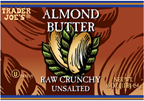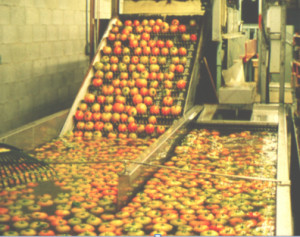If Chapman is the canning queen, Linda Harris is the almond queen (and was on my PhD supervisory committee all those years ago).
 Harris, a cooperative extension specialist who researches food safety at the University of California, Davis, told NPR, “There is no legal definition, no federal definition of the word ‘raw,’ ” and that studies show pasteurization doesn’t change the nutritional value of almonds.
Harris, a cooperative extension specialist who researches food safety at the University of California, Davis, told NPR, “There is no legal definition, no federal definition of the word ‘raw,’ ” and that studies show pasteurization doesn’t change the nutritional value of almonds.
She also predicts that sterilization of a lot more foods will soon be required by law.
NPR was going after the what-does-raw-really-mean angle.
All California almonds — which would be virtually all the almonds in the country — are either heat-pasteurized or treated with a fumigant. The processes, which have been required by law since 2007, are intended to prevent foodborne illness. But almond aficionados say the treatments taint the flavor and mislead consumers.
Yup, heard that before, think raw milk.
Aficionados generally don’t have PhDs in food science, but I guess it makes good press.
In a warehouse near Newman, Calif., run by the Cosmed Group, millions of almonds are heated in huge metal containers. The temperature inside the chambers gradually rises to 165 degrees Fahrenheit. The goal is to ensure through steam pasteurization that the almonds don’t carry bacteria from the fields to consumers.
“As the steam is coming out, it rolls around in the chamber so it can penetrate everything,” plant manager Dianne Newell explains.
“The whole process from start to finish is about nine hours,” says Newell — though the timing can vary widely at different facilities, depending on how they choose to steam the nuts.
Handlers open hundreds of boxes destined for the steaming vats. Almonds aren’t the only crop treated here: The facility also processes sunflower seeds, flax seeds, chia seeds, walnuts, hazelnuts, Brazil nuts, pecans, pistachios, cashews, sun-dried tomatoes, dried apricots, dried strawberries and dried blueberries.
But almonds are the only nut, seed or dried fruit that must — by law — be pasteurized. If they’re not steamed, they must be fumigated with a chemical called propylene oxide, or PPO.
The regulation is a result of two salmonella outbreaks traced to almonds in the early 2000s. Almonds are not any more susceptible to the bacteria than other nuts and dried goods, but the Almond Board of California wanted to prevent future outbreaks. So the industry asked the U.S. Department of Agriculture to implement a rule requiring raw almonds grown in California’s Central Valley to be pasteurized. In 2007 the USDA issued the “almond rule.”




 porn dinner:
porn dinner: After receiving a call from two customers saying they had bought a bag of almonds from the store and found live moths inside the bags, KTVU decided to check it out.
After receiving a call from two customers saying they had bought a bag of almonds from the store and found live moths inside the bags, KTVU decided to check it out.